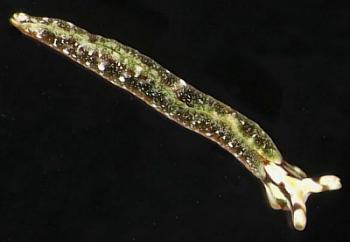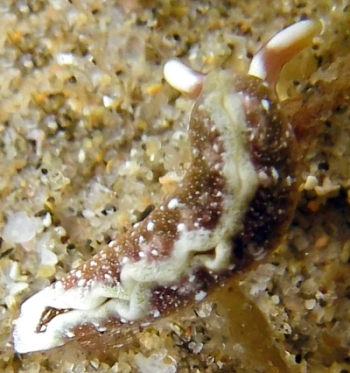

Thuridilla kathae
Gosliner 1995
Order: SACOGLOSSA
Superfamily: ELYSIOIDEA
Family: Elysiidae
DISTRIBUTION
Indo-West Pacific
PHOTO
Heron Island [Great Barrier Reef] under dead coral slab at the reef crest, 12 November 2000. 12 mm long. PHOTOS: Julie Marshall.
Described as rich green with a scattering of large and small opaque white spots. The large spots are on low papillae. There is a broad band at the margin of the parapodia which is cream to light yellow. There is a Y-shaped opaque white mark on head that extends to the base of the rhinophores which is follwed by a patch of green then another opaque white patch. The tips of the rhinophores are orange, and there is also an orange margin to the anterior edge of the foot.
These photos from Heron Island lack the broad white/cream parapodial border noted in the original description.
Reference:
• Gosliner, T.M. (1995) The genus Thuridilla (Opisthobranchia: Elysiidae) from the tropical Indo-Pacific, with a revision of ther phylogeny and systematics of the Elysiidae. Proceedings of the California Academy of Sciences, 49(1): 1-54.
Rudman, W.B., 2001 (February 12) Thuridilla kathae Gosliner 1995 . [In] Sea Slug Forum. Australian Museum, Sydney. Available from http://www.seaslugforum.net/find/thurkath
Related messages
Re: Elysia rufescens from Reunion Island
June 30, 2006
From: Colin Ogden

Concerning message #16935:
Hi Bill,
I hhink this is a Elysia rufescens, taken by Jesse Feltmann here at Sodwana Bay. If my ID is correct their distribution is quite spread.
Locality: Sodwana Bay, rock pool, South Africa, Indian, Mar 2006, rock pool. Length: 15mm. Photographer: Jesse Feltmann
Regards
Colin
.
scubaco@iafrica.com
Ogden C. M., 2006 (Jun 30) Re: Elysia rufescens from Reunion Island. [Message in] Sea Slug Forum. Australian Museum, Sydney. Available from http://www.seaslugforum.net/find/17008Dear Colin,
As I said in reply to Hugues' message, Terry Gosliner reported one specimen of E. rufescens from Sodwana Bay. However, I am pretty sure your animal is Thuridilla kathae. It is nice to get an example of this colour form. It is much closer in colour pattern to the photo accompanying the original description, than the photos at present on the Forum
Best wishes,
Bill Rudman
Re: Thuridilla kathae
February 17, 2001
From: Julie Marshall
Dear Bill,
Thanks for reproducing my photos so well. I haven't found Thuridilla kathae with the broad white cream parapodial border as illustrated in Terry Gosliner's paper. In all other respects my animal matched his description but to make sure that my animal was this species I sent Terry the photos and he has confirmed that the identification is correct. My animal had a thin white parapodial border heavily speckled with green.
Best wishes,
Julie Marshall
j.marshall@latrobe.edu.au
Marshall, J., 2001 (Feb 17) Re: Thuridilla kathae. [Message in] Sea Slug Forum. Australian Museum, Sydney. Available from http://www.seaslugforum.net/find/3828Thanks Julie,
I didn't have any problem with your identification. I just thought that with a relatively new species that we have few records of, it would be good to get as much information on variability from you as possible.
Bill Rudman
Thuridilla kathae from Heron Island
February 16, 2001
From: Julie Marshall


Dear Bill,
Attached are two pictures of Thuridilla kathae found at Heron Island [Great Barrier Reef] under a dead coral slab at the reef crest at low tide on November 12, 2000. Its size was 12 mm. Thuridilla kathae is most similar to T. flavomaculata but that species has black longitudinal lines on the rhinophores, yellow spots on the surface of the body, and lacks the orange colour on the base of the parapodia and the foot.
Best wishes
Julie Marshall
j.marshall@latrobe.edu.au
Marshall, J., 2001 (Feb 16) Thuridilla kathae from Heron Island. [Message in] Sea Slug Forum. Australian Museum, Sydney. Available from http://www.seaslugforum.net/find/3759Thanks Julie,
I don't recall ever seeing this species. in Terry's original description he notes a broad white/cream parapodial border. have you ever seen a specimen with such a border?
Cheers,
Bill Rudman
